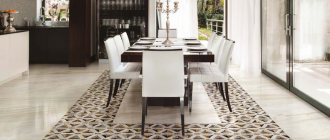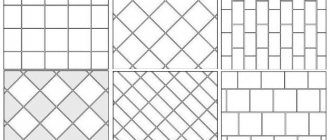The interior of any room consists of many details that should harmoniously complement each other. In the kitchen, one of the important elements is the apron. It is not only designed to beautifully decorate the workplace, but also protects the wall from dirt and other influences.
Boar tiles are increasingly being used for backsplashes. What it is and what interior it fits into, we will find out further.
What is a hog tile
This tile is a type of ceramic small-format rectangular tile. It is laid like a brick. It was originally intended as building facades and was called clinker.
Further, her path went through underground passages, mainly in the subway. That is why in the USA and Great Britain, where they first began to use it for this purpose, they began to call it “subway” tiles. But information about when and who began to use it at home has not been preserved.
Boar tiles quickly gained popularity due to their good quality and amazing similarity to the original - brick. However, it remains a mystery why in Russia it received such a name? All because of the resemblance to a pig's snout. The end, although rectangular in shape, has two holes. At the construction site, they informally began to call her the pig. So the new name for clinker took root among the people and continues to exist.
Most popular colors
The palette of three-dimensional tiles is diverse, it is not just replete with abundance, a rich assortment allows any of us to find ideal solutions to realize the intended design.
White “hog” tiles are considered traditional. It is universal, suitable for decorating small and large rooms. It’s easier than ever to find a colored companion for such material: white goes well with red and yellow shades, with the entire turquoise palette.
Black tiles are good for decorating large rooms with high ceilings. Designers love to combine dark tiles with light tiles. A cool gray palette together with black tiles helps to correct and visually eliminate imperfections in the geometry of the room. So, for example, if the bathroom is a long, elongated room, then only one accent wall should be finished with black tiles, and the remaining surfaces should be tiled with gray tiles. Then the trailer effect disappears.
A blue “hog” is traditionally chosen to decorate plumbing fixtures. In this situation, color is associated with freshness and lightness. As a companion to blue tiles, turquoise, gray, blue and white work well.
Red tiles, which have a glossy finish, are always perceived aggressively, so tiles of this color cannot be used to decorate the entire surface of the walls. But as a bright spot, an accent, such a solution may well be in a city apartment. The main background in this case can be ivory tiles. The glossy bright tiles combine beautifully with the white “hog”.
Yellow and brown colors must be used extremely carefully when decorating bathrooms and toilets. Both shades can be combined, but it is better to choose muted shades for this. The choice of tiles of such colors is justified when you want to create a sunny mood. The use of green tiles deserves the same recommendations.
The advantages of such material
Boar tiles are perfect for a kitchen backsplash. This is due to many advantages of the material:
- Excellent sanitary and hygienic qualities. There is no accumulation or development of microorganisms, and thanks to the solid structure without pores, the tiles do not accumulate dirt, which makes them easy to clean.
- A varied selection of colors and pattern textures. In addition, it can be produced to order, decorated with an individual drawing or photograph. Therefore, the hog fits most interior styles.
- High temperature resistance. When making it, firing is used at about 1000 °C, so the tile is definitely not afraid of elevated temperatures from the stove.
- Simple installation technology that does not require expensive tools.
- The material is harmless and environmentally friendly , does not emit gases and does not cause allergies.
Boar tiles have almost no disadvantages. The only thing that can be noted is the relatively high price and low impact resistance.
Existing sizes
Today, boar tiles are available in different sizes. On sale you can find small tiles, the dimensions of which are 7.5 by 10 cm, large tiles, the dimensions of which are 28.5 by 8.5 cm.
There are GOST standards, according to them, the long side of a standard tile should not extend beyond 12-25 cm, and the wide side 6.5-10 cm. To decorate a bathroom, tiles of the “hog” type are most often purchased, the long side of which is no more than 20 cm and width no more than 10 cm.
The thickness is almost always the same; according to GOST standards it should be 80 mm. These are the dimensions of the tile without convex edges. With them, the thickness often reaches 2 cm.
The dimensions of the tiles are taken into account when decorating a particular room. For example, for tiling small rooms, experts recommend choosing medium-sized tiles; large modules visually “eat up” the space. The use of large tiles is justified only for decorating large rooms: spacious bathrooms and plumbing units.
What style does a hog tile apron go with?
These tiles are perfect for most styles, especially if they are white or beige. It will be ideal for country, Provence and classics. The first two styles are rustic, characterized by simplicity and naturalness. A small brick will only add originality to the design and complement it with the spectacular appearance of the apron.
The classic is the presence of massive wooden furniture. The entire interior is filled with nobility, with clear, simple lines and images. The boar will only add even more aristocracy, especially when choosing light colors.
The tiles will be an ideal solution for Scandinavian or loft style. It is also often used in art deco. An unusual layout is relevant here, contrast is allowed. Including bricks can be black and white and placed in a checkerboard pattern.
It is worth taking into account all the features of the chosen style. A glossy surface is not always suitable. Most often they use matte, which will fit even more into the interior of the above design directions.
Advice! If you want to make your apron bright, then you should take a closer look at Spanish manufacturers who present a wide variety of rich shades to the market.
Varied design
Continuing to describe the technical characteristics of the “hog” tile, it is necessary to note the presence of a variety of designs. Traditional tiles, as mentioned above, have chamfers along all edges; it is thanks to their presence that the tiles look three-dimensional. But the shape of the chamfers can be different: have clear pointed lines or smooth rounded edges. The choice of a particular product largely depends on the design concept of the room being renovated.
The traditional “hog” always has a monochrome color, but modern manufacturers, releasing new collections, offer consumers surfaces that imitate natural marble or brick. There are tiles on sale that have a texture similar to wood. As the latest know-how, glass tiles “hog” are presented. With its help, exclusive interiors are created that can boast a special zest.
Note! Decorative “hog” tiles are best used to accentuate and highlight any one functional area. Otherwise, the interior will turn out to be too bright and saturated.
Another important circumstance should be noted: all hog tiles are divided into two large groups. It comes in matte and glossy. Gloss, due to the presence of a reflective surface, helps to create ceremonial, elegant interiors. Steles lined with it become lighter, which is very important for small bathrooms and plumbing units. Matte tiles are most often used for tiling toilets; they can often be found in the interior of a living room designed in a loft style. Using this solution, designers highlight functional areas.
Layout options
- Horizontally in a running start. This is a traditional brick-like layout. It is the most versatile and easiest to implement. The main task here is to position it in a perfectly even horizontal line.
- Horizontal stackable. The main thing here are the vertical seams, which must coincide with each other. This is an ideal proposal for the Scandinavian style. Moreover, you can choose a grout of a different color from the tile.
- Herringbone. This arrangement is at an angle of 45 or 90 degrees. It looks original and will not taste trivial.
- Diagonally. This option is also quite unusual and is suitable for small kitchens. Here it is important to choose a grout that matches the tone of the tile.
- Vertical with offset. This option is suitable for spacious rooms. The tiles should be chosen in a small size.
- Vertical stackable. In this case, the installation must be done as perfectly as possible, then the look will be very stylish and original.
Important points when choosing subway tiles
1. If the apron is located opposite the window, opt for matte tiles. Otherwise, the slightest dirt and irregularities will be noticeable.
2. Before cladding with your own hands, carefully take measurements taking into account the horizontal and subtleties described above.
3. When planning sockets and hanging elements, remember: fastenings should not fall on joints or chamfers.
4. Many manufacturers offer half square tiles with factory processing in their collections. They will help fill the gaps in the masonry without unnecessary cutting.
Original or imitation?
The price of the issue and the above nuances of subway tiles allow us to consider alternative options for designing a kitchen apron.
The most budget-friendly solution is PVC panels embossed to look like brick. This solution has its own characteristics. The main ones are fragility and “appearance”, far from the original.
The labor-intensive process of preparing and installing heavy elements can be a reason to choose standard ceramics without chamfers and other elements that complicate installation. The market offers ready-made carpets made from brick tiles and other façade textures.
How to choose grout
Just like tiles, the variety of grout colors gives you something to think about. You can choose white, black, gray, beige, or you can match it to the tone of the tile itself. In any case, the most important thing is that it is of high quality, otherwise it will quickly darken.
The water resistance of the material is important, since the apron often gets dirty and needs to be washed, and resistance to temperature changes is also necessary.
Advice! To avoid darkening of the seams, it is recommended to purchase a mixture based on epoxy resin. It does not absorb water and dirt, but hardens very quickly. Therefore, in this case, the laying should be done by a professional who will do it as quickly as possible.
Dimensions, color layouts and interior appearance
In stores, ceramic wall tiles with beveled edges are offered in a variety of sizes from 50 to 450 mm in height and from 100 to 450 mm in width. But the most common options are products 75x150, 75x300, 100x200 and 100x300 mm.
In terms of color, “metro” interior tiles can be plain (most often white, black, beige or brown) and with patterns like wood, stone, mosaic, etc. In this case, light options are usually used as the basis for the design, and dark ones only to add emphasis to it. However, for example, ceramics with blue or blue glaze also look good in bathrooms.
With the help of well-chosen collections of boar tiles, you can create an interesting pattern on the wall
Styling tools
The hog finishing tiles are installed according to the principle of conventional ceramic tiles. To do this you will need the following tools and materials:
- Drill with kneading attachment and container;
- Rubber or plastic spatula, preferably flexible;
- Rubber mallet;
- Small construction float;
- Spatulas with teeth;
- Soft sponges and rags;
- Sharpening machine, tile cutter;
- Marking tool;
- Screws for fastening the profile;
- Metal or wooden profile;
- Tile adhesive, grout, water.
The master's work is afraid
Laying such demanding tiles as “hog” requires experience and some ingenuity. Therefore, to get a good result, we advise you to invite a good tiler. In addition, it is necessary to strictly follow the technology for laying ceramic tiles and use only certified materials: putties, primers, tile adhesives and grouts. Don’t skimp on high-quality finishing materials, then you won’t have to regret wasted money and time.
Don’t be afraid of the difficulties of installing a “hog”, because all of them can be overcome, and the result is so good that over time you will forget about them and admire the beautiful design of your room.
Preparatory work
Before you begin installing the tiles, you must carefully prepare the surface so that it is smooth and free of flaws. First of all, you need to get rid of the old surface, such as wallpaper, paint, and remove all dirt. Next you should apply putty and level the walls with it. It must dry, after which a primer is used.
The next step is marking. Here a marker, upholstery cord, plumb line, and building level will come to the rescue. First, the lower horizontal line is applied, the height of which depends on the height of the furniture. Depending on the installation method, the remaining lines are applied horizontally, vertically or at an angle. Finally, the profiles are attached to the wall.
Classic herringbone
One of the favorites is the traditional herringbone method of laying boar tiles. It can be used on an accent wall. You don’t have to worry about interior trends—this method will never go out of style!
Photo:
Apron installation
Installation work begins with mixing tile adhesive. This is done immediately before laying. The volume of glue should be such that it can be used for no more than 40-50 minutes. It is applied both to the wall and to the tiles themselves using a spatula.
Next, you need to make stripes with a notched trowel. There is no need to apply all the glue to the wall at once. There is enough volume for 2-3 slabs so that it does not start to dry out.
Immediately after application, work moves on to laying the first row. You should start from the far corner in relation to the entrance to the kitchen. The bottom edge of the tile should rest against the profile. It must be pressed against the wall. Crosses are placed between the elements, which serve as a separator and ensure an equal distance between each hog. Remaining glue is removed no earlier than an hour later. This also applies to crosses.
Generalization on the topic
As you can see, the tile, which has such an interesting name, has a large number of operational advantages. With its help today it is easy to implement classic design concepts and create modern styles. But if you give preference to the described option, you must be prepared to pay more for the finishing than purchasing traditional tiles. The boar is not suitable for the first experiments in mastering repair technologies. Laying such tiles requires certain experience and knowledge.
Grouting joints
The glue must dry completely and only then, approximately the next day, the seams are sealed. Apply it with a soft plastic spatula. Black rubber is not suitable in this situation, as it leaves marks on the ends.
Excess material can be removed after 30-40 minutes. A sponge is used for this. After complete drying, the apron is completely washed and polished, and the profile that was intended for supports is removed.
Color solutions
The color, shade, texture of the tiles should harmoniously fit into the design of the room, complement other interior elements and correspond to the individual preferences of the owner of the room. Boar wall tiles are chosen from a variety of colors, focusing on the following:
- Black. Looks great in large rooms. When using it, visual accents are well placed in light colors.
- White. Considered a universal color. It can complement other colors, for example, black, blue, pink, shades of dark colors. But it can act as an independent primary color.
- Black and white gamma. Classic. Used in many interior design styles. White tiles with splashes or a belt of black (gray) color look great.
- Red. Decorating a section of the wall with this color will accentuate the attention of those present. But the color is somewhat aggressive. Therefore, it is recommended to use it in combination with other bright colors, for example, light turquoise, olive, green or blue.
- Blue. The color of calm and tranquility. Mainly used for finishing baths and toilets. When using panels with other colors in the ornament, gloss softens the composition. Successfully complements purple, turquoise and lilac colors.
- Compositions of soft tones (burgundy, turquoise, milky, brown and dark shades of other colors) are important to combine with other elements of the premises - furniture, curtains, wall decorations, etc.
Advice! When choosing the color of a tile or determining a combination of shades, it is recommended to familiarize yourself with photos of completed compositions on the Internet. Many well-known manufacturers offer ready-made original solutions, for example: Kerama Marazzi hog tiles, Ege Seramik, Absolut Keramika, Serenissima Cir catalogs and others. Before making a purchase, you should try to combine colors on exhibition tile samples.
Useful tips
Tiles must be purchased with a reserve. It is about 10%. It always requires pruning, as a result of which part of it gets damaged. Before laying it is very important to level the wall, otherwise due to unevenness it will be difficult to lay out the tiles without flaws.
In addition, the service life of the hog directly depends on this preparation. The seams must be perfect, so it is better to trust a professional, especially if the layout is unusual.
It must be remembered that convex tiles are thicker and therefore heavier. Therefore, it must be attached more carefully, applying a larger layer of glue for standard material. The seams should be between 2 and 5 mm thick. Of course, the thicker it is, the better the look, but in this situation the complexity of the work increases.
Thus, boar tiles have won their rightful place in the kitchen interior. An apron made of this material has an attractive appearance, the originality of which depends on the laying of these bricks.
In addition, the material is very easy to wash. It is interesting that the seemingly soiled white color in this case, on the contrary, will be advantageous. This is because stains, possible drips and drops of water are invisible on such tiles. They are very easy to wipe with a regular damp cloth.
Regarding design, it is important that for any style it is possible to choose suitable hogs that will complement it and give the desired atmosphere. Manufacturers provide a wide selection of colors and patterns that are sure to suit any kitchen.
Classical
A classic of the genre is laying hog tiles according to the principle of brickwork, that is, horizontally with an offset. This method is always relevant, and this is how the walls in European subways are decorated, thanks to which the “hog” has gained worldwide popularity. If the white color of the tiles seems too boring to you, pay attention to the color offers from manufacturers.
Photo: construction2style.com
1/3
Photo: construction2style.com
2/3
Photo: construction2style.com
3/3











